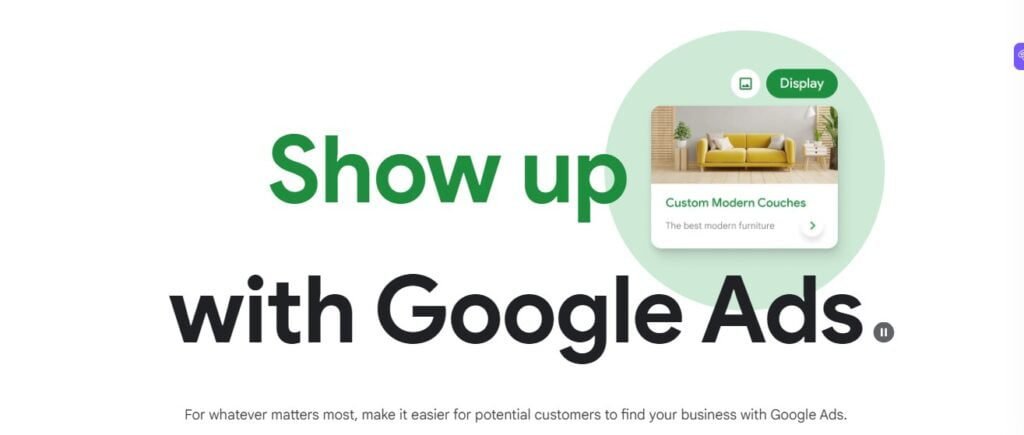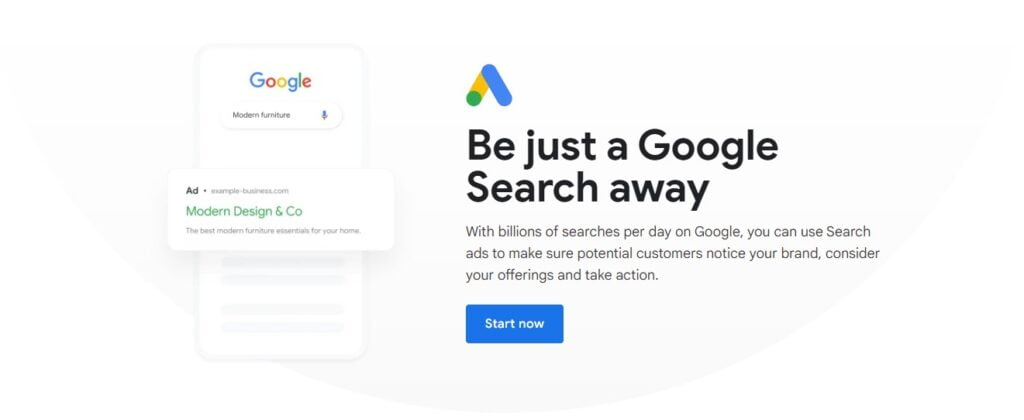This post may contain affiliate links. Without any extra cost to you, we earn from qualifying purchases, if you buy something through one of those links. By clicking on the affiliate links, you automatically agree to our terms and conditions.
Google ads platform is one place that offers businesses channels to contact their target audience and enhance sales online. Among the number of options available, the Google Ads platform stands out as a vital tool for businesses of all kinds to fulfil their marketing goals. Formerly known as Google AdWords, Google ads platform delivers a robust and comprehensive set of tools that empower advertisers to construct compelling campaigns. In this post, we look into the various benefits of the Google Ads platform, demonstrating how it can be a game-changer for businesses aiming to optimize their online visibility, reach, and conversions.
What is Google Ads Platform?
Before we get into the rewards, let’s grasp what the Google Ads Platform is all about. Formerly known as Google AdWords, Google Ads Platform is an internet advertising platform developed by Google. It allows businesses to generate and display advertisements on Google’s massive network, which includes search results, websites, mobile apps, and videos. The site operates on a pay-per-click (PPC) premise, where advertisers only pay when users click on their adverts.

Google often extends promotional credits to new advertisers to provide a welcoming boost. These credits are applied to an advertiser’s account and can be used to offset a percentage of the initial advertising spend. This offers an ideal opportunity for firms to dip their toes into online advertising without instantly denting their budget. New advertisers can experiment with different ad forms and strategies while having a financial buffer. These terms and conditions to qualify for Google promotional ads credits are flexible.
Benefits of using Google Ads Platform
Let’s explore the myriad benefits of employing the Google Ads Platform, illuminating how it may improve your business’s online visibility and promote speedy growth.
- Unparalleled Reach and Visibility
With over 3.5 billion searches made daily, Google is unquestionably the entryway to the internet for most consumers. According to StatCounter, Google alone account for 92.08% of internet search in July 2023 while Bing follow with 2.98%. Leveraging the Google Ads network allows businesses to tap into this vast user base and promote their products or services to potential clients actively looking for relevant keywords.
2. Quick and Measurable Results
Unlike traditional advertising strategies, Google Ads gives practically quick results. Once a campaign is set up and approved, adverts can appear in search results or websites within hours. This mobility is beneficial for time-sensitive marketing or product launches. Moreover, the platform’s analytics capabilities provide real-time data, allowing marketers to measure the efficacy of their campaigns and make required adjustments on the fly.
3. Precise Targeting Capabilities
One of the noteworthy advantages of the Google Ads platform is its ability to accurately target specific demographics, geographies, and user behaviours. Advertisers can narrow down their target depending on criteria such as age, gender, interests, and even device types. This precision guarantees that marketing funds are invested in showing ads solely to users who are most likely to convert, optimising advertising campaigns’ ROI.
4. Flexible Budgeting Options
The Google Ads platform is designed for versatility, appealing to businesses of various sizes and budgets. Its flexible budgeting tools allow advertisers to manage resources according to their financial capacity and strategic aims. With no minimum expenditure requirement, businesses can commence campaigns with modest costs, providing an accessible route for startups and small organizations to create a digital presence. Additionally, the pay-per-click (PPC) model ensures that advertisers only pay when viewers connect with their advertising, delivering a cost-effective technique that explicitly ties expenditure to actual outcomes.
Furthermore, advertisers can create daily budgets, preventing campaigns from surpassing predefined expenditure restrictions. This not only improves financial control but also avoids unplanned expenses. Additionally, the bidding system allows advertisers to alter bids for individual keywords, letting them compete effectively within their chosen niches. The auction-based architecture of Google advertising ensures that businesses with various budgets may engage on a level playing field, as advertising is rated not just based on financial prowess but also on ad quality and relevancy.
5. Performance Tracking and Analytics
When it comes to digital marketing, the skill to measure the efficacy of ad performance is crucial. Google Ads Platform gives advertisers a wealth of analytical tools to track clicks, impressions, conversions, and other essential metrics. By leveraging these data, organizations can better understand their audience’s behaviour, allowing them to adjust their tactics and optimize their campaigns for better outcomes.
With Google Analytics for example, advertisers to measure particular actions consumers take after clicking on an ad. Businesses may immediately attribute actions like buying, signing up for a newsletter, or filling out a contact form to their advertising efforts. This data enables marketers to determine which keywords, ad language, and landing pages are the most effective in driving conversions, allowing them to fine-tune their tactics for maximum impact.
6. Remarketing Opportunities
Many internet users need to convert on their initial engagement with a website. Remarketing, a service supplied by the Google advertising platform, addresses this difficulty by targeting users who have previously engaged with a business’s website or advertising. This establishes several contacts with potential clients, improving the possibility of conversion over time. Remarketing is very helpful for reinforcing brand awareness and nurturing leads along the sales funnel.
7. A/B Testing for Optimization
Successful digital marketing hinges on ongoing improvement. The Google Ads platform allows this through A/B testing, wherein advertisers may generate different versions of ads or landing pages to see which ones work better. Businesses can adjust their campaigns and increase conversion rates over time by regularly testing various aspects such as ad wording, headlines, and images.
The A/B testing method begins by defining a specific element to test, which may be anything from ad headlines and graphics to call-to-action buttons or even landing page layouts. Once variations are developed, Google Ads distributes these versions randomly to individuals within the specified audience. By measuring the performance of each variant against a given goal, advertisers can draw precise conclusions about which version is more effective in achieving desired outcomes.
8. Geotargeting for Local Business Growth
For businesses with a physical presence, geotargeting is a valuable feature supplied by the Google Ads platform. This feature allows marketers to display their advertising to consumers within a defined geographic area. This precision is crucial for local firms aiming to attract neighbouring clients. Whether it’s a restaurant, a retail store, or a service provider, geotargeting ensures that marketing efforts are directed where they count most.

Geotargeting, or location targeting, helps businesses customize their advertising efforts to local markets, optimizing their impact and boosting growth within their immediate vicinity.
For brick-and-mortar retailers, service providers, or restaurants wanting foot traffic, geotargeting enables them to focus their adverts on users within a set radius of their physical location. This proximity-based targeting ensures that marketing efforts are targeted toward potential clients more likely to convert into visits or buys. For instance, a local bakery can launch a geotargeted campaign to market its freshly baked goodies to people within a few miles of its location, effectively targeting folks in the region and searching for a fast treat.
Geotargeting goes beyond just proximity. Advertisers can also target specific regions, cities, or nations to coincide with their strategic goals. This is particularly important for firms with many locations or those wishing to expand their presence to other markets. For instance, a regional hotel chain might apply geotargeting to customize adverts for each location, ensuring that users in different areas receive relevant offers and information.
9. Integration with Google Ecosystem
The Google Ads platform smoothly connects with several other Google services, boosting its potential impact. Integration with Google Analytics, for example, provides a comprehensive view of user behaviour from click to conversion. Additionally, the platform may sync with Google My Business, enabling businesses to display important information such as location, contact details, and reviews immediately in search results.
The Google Ads platform’s connection with the Google ecosystem is a strategic advantage that permits marketers to wield a holistic array of tools. By leveraging data, insights, and platforms like Google Analytics, Google My Business, YouTube, Google Search Console, and the Google Display Network, businesses can refine their targeting, optimize their strategies, and take their campaigns to new performance levels. This linked ecosystem maximizes the reach and impact of advertising efforts and positions organizations to thrive in the dynamic and competitive digital market.
10. Constant Evolution and Innovation
Google is recognized for its devotion to innovation, and the Google Ads platform is no different. Google ads platform is regularly updated with new features and tools that respond to changing user behaviour and technical improvements. Staying up-to-date with these upgrades ensures advertisers are constantly equipped with the latest tools to maximize their advertising efforts.
Maximizing Google Ads Success
While the benefits of Google Ads are enormous, attaining the best results needs a planned approach. These are some of the strategic factors to consider when planning an ad campaign.
A. Keyword Research and Optimization.
Keyword research is the foundation of effective advertising. They thoroughly research and select appropriate keywords, and adequate bidding guarantees that your advertising is seen to the right audience.
Keywords are the building elements of search advertising. They are the words and phrases that consumers type into search engines when looking for information, products, or services. Effective keyword research involves selecting the terms that resonate best with your target audience, align with your services, and have significant search traffic.

B. Compelling Ad Copy and Visuals
Crafting captivating ad language that answers customer demands and showcases unique selling factors is critical. Visual components like photos or videos should connect with the ad’s theme and engage with the viewer.
Ad copy lets you make a solid first impression and effectively explain your value proposition. Effective ad language and images work hand in hand to deliver your message, resonate with your target audience, and motivate action.
C. Landing Page Optimization
An often ignored issue is optimising the landing page to which the ad refers viewers. The landing page should deliver a seamless user experience with relevant content and a clear call-to-action (CTA).
A good Google Ads campaign doesn’t end with compelling ad language and imagery. It extends to the landing page—where people are headed when they click on your ad. Landing page optimization is a vital step that assures a flawless user experience, corresponds with the user’s intent, and maximizes the odds of converting clicks into significant actions, such as purchases or sign-ups.
D. Continuous Monitoring and Refinement
Google Ads programs require continual monitoring. Analyze performance numbers trends and adjust keywords, ad text, and targeting settings to maximize results over time.
You can maintain relevance, engagement, and conversion rates by staying vigilant, adapting to changing dynamics, and using data to drive decisions. Continuous monitoring and refinement constitute the backbone of a dynamic and effective advertising strategy. This continual process entails painstakingly watching performance metrics, generating valuable insights, and making intelligent modifications to keep your campaigns finely tuned and aligned with your goals.
E. Cost-Efficiency and ROI
One of the noteworthy qualities of Google Ads is its cost-efficiency. Advertisers only pay when users click on their adverts, ensuring that funds are allocated to meaningful engagement. Additionally, the ability to analyze conversions and connect them to specific advertising permits marketers to measure their return on investment (ROI) correctly.
F. Potential Challenges to Consider
While the benefits are enormous, Google Ads has its share of issues. The competition for prominent keywords might be severe, resulting in more extraordinary bidding expenses. Advertisers must also stay up with developing algorithms and market trends to preserve their competitive edge.
Overcoming the hurdles, Google Ads offers demands a blend of strategic thinking, continual learning, and agility. By staying updated on industry trends, leveraging data to drive decisions, and employing creative techniques, advertisers can identify solutions that enable them to leverage the benefits of Google Ads while limiting hazards.
Conclusion
The Google Ads Platform has changed the digital advertising market, giving businesses a powerful tool to engage with their target consumers and create tangible results. With its precise targeting, numerous ad formats, quantitative analytics, and integration capabilities, Google Ads offers many benefits for marketers. By approaching campaigns intelligently, consistently improving strategies, and staying updated about industry trends, businesses can harness the full potential of Google Ads and generate unparalleled growth in the digital sphere.














